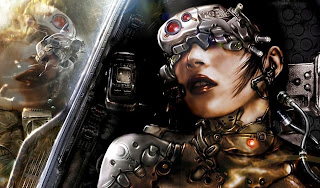There
are several cultures out there in the world. Odds are, you are probably a part
of a culture or several cultures. You may not be aware but you could even be a
part of a new culture that exists in the cyber world. Technology, over that
past several years, has allowed this “cyberculture” to grow exponentially. However,
the people who have participated to this cyber world have ultimately created
this cyberculture. The book “An Introduction to New Media and Cybercultures”
will help us evaluate what the people have provided to turn this cyberspace
into a cyberculture.
 Virtual worlds allow the user to transcend geography and
the body. It is mankind’s ultimate evolution to become a hybrid of technology.
Humans must overcome of the body’s limitations in favor of pure rationality and
thinking. According to the book, it states that Hand Moravec described the body
as “mere jelly.” In other words, the body is just a less significant shell
compared to the knowledge and consciousness that it contains. In the virtual
world, mankind doesn’t have to deal with diseases, pain, or aging as a
limitation to their lives. These values have become a prime directive to many
who study cybercultures as way to incorporate data into the body and the
extension of consciousness into cyberspace. Even today you can see the technological advancements
in prosthetics as forefront to a posthuman era.
Virtual worlds allow the user to transcend geography and
the body. It is mankind’s ultimate evolution to become a hybrid of technology.
Humans must overcome of the body’s limitations in favor of pure rationality and
thinking. According to the book, it states that Hand Moravec described the body
as “mere jelly.” In other words, the body is just a less significant shell
compared to the knowledge and consciousness that it contains. In the virtual
world, mankind doesn’t have to deal with diseases, pain, or aging as a
limitation to their lives. These values have become a prime directive to many
who study cybercultures as way to incorporate data into the body and the
extension of consciousness into cyberspace. Even today you can see the technological advancements
in prosthetics as forefront to a posthuman era.
Who governs a cyber-world? The digital world may be a revolution and solution
to an improved citizen-state; cybercultures are still subject to governance. Through
protocols, this governance will not only regulate hardware but data transfers
as well. Protocols are a set of rules that determine the allocation of the
internet addresses, domain names and servers. Even though cyberspace is governed,
many domains have their own politics. In a sense, these are regional governors
that still answer to the protocols. In conclusion, it will take several years
and several political debates before we can ultimate say who rules cyberspace,
however this does not deter our goal for transcendence into the virtual world.
 In a counter movement to transcendence into the virtual
world, there is a growing movement of a different kind of transcendence into
the material world. Many people who claim that they are following the cyberpunk
counterculture strive for evolution of their own bodies. “Cyberpunk is literary
expression of both, a technologically minded counterculture and an ethos of posthumanism”
(Nayar 37). To put this in a way you can better understand, the cyberpunk culture
rejects the idea of transferring our consciousness into a cyberworld, but
rather prefers to have technology advance their own bodies and improve their
ability to hack into the virtual world without completely leaving their bodies.
In a counter movement to transcendence into the virtual
world, there is a growing movement of a different kind of transcendence into
the material world. Many people who claim that they are following the cyberpunk
counterculture strive for evolution of their own bodies. “Cyberpunk is literary
expression of both, a technologically minded counterculture and an ethos of posthumanism”
(Nayar 37). To put this in a way you can better understand, the cyberpunk culture
rejects the idea of transferring our consciousness into a cyberworld, but
rather prefers to have technology advance their own bodies and improve their
ability to hack into the virtual world without completely leaving their bodies.
Conclusion
 In conclusion, we are living
in era where we, as humans, can witness beginnings of a new culture and
sub-human species. As we evolve, we witness countless battles on whom or what governs
this new frontier known as cyberspace, however, our goals for transcendence
will eventually cancel any petty quarrels. With such cultures as cyberpunk, we
can our species become a hybrid of synthetics and organics together. Synthetics
are already apart of us; could you imagine your life without them?
In conclusion, we are living
in era where we, as humans, can witness beginnings of a new culture and
sub-human species. As we evolve, we witness countless battles on whom or what governs
this new frontier known as cyberspace, however, our goals for transcendence
will eventually cancel any petty quarrels. With such cultures as cyberpunk, we
can our species become a hybrid of synthetics and organics together. Synthetics
are already apart of us; could you imagine your life without them?


